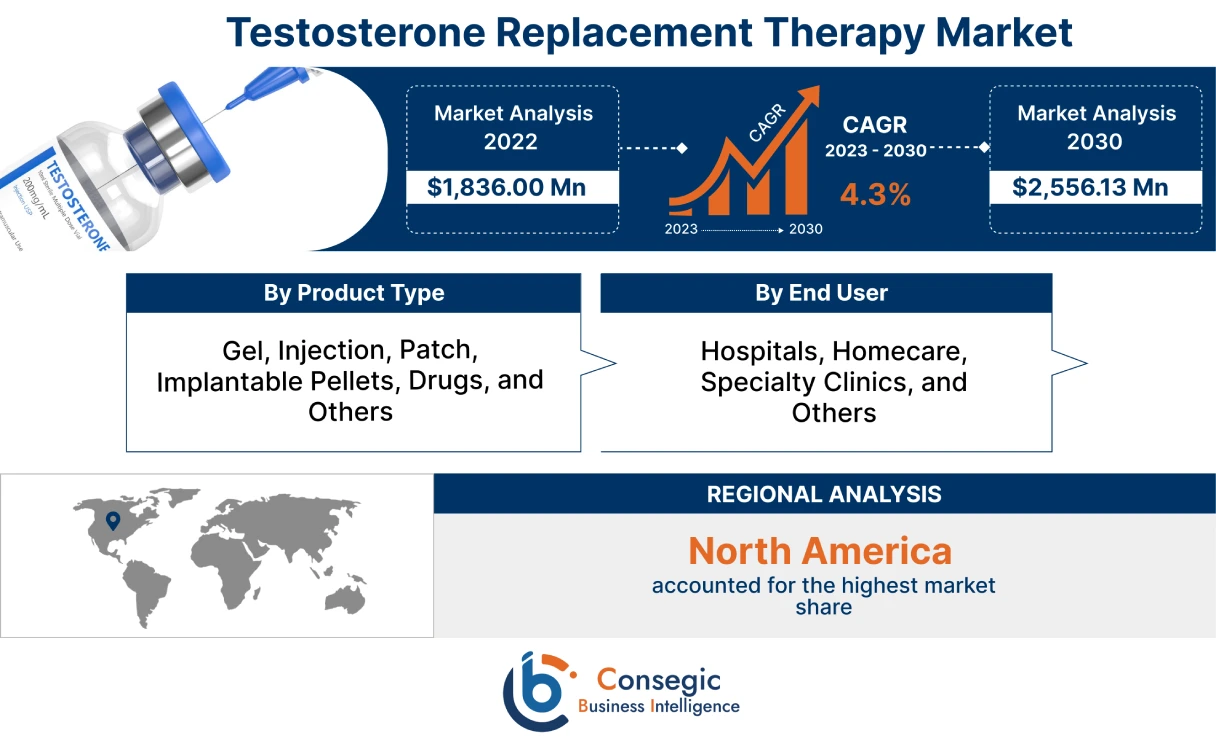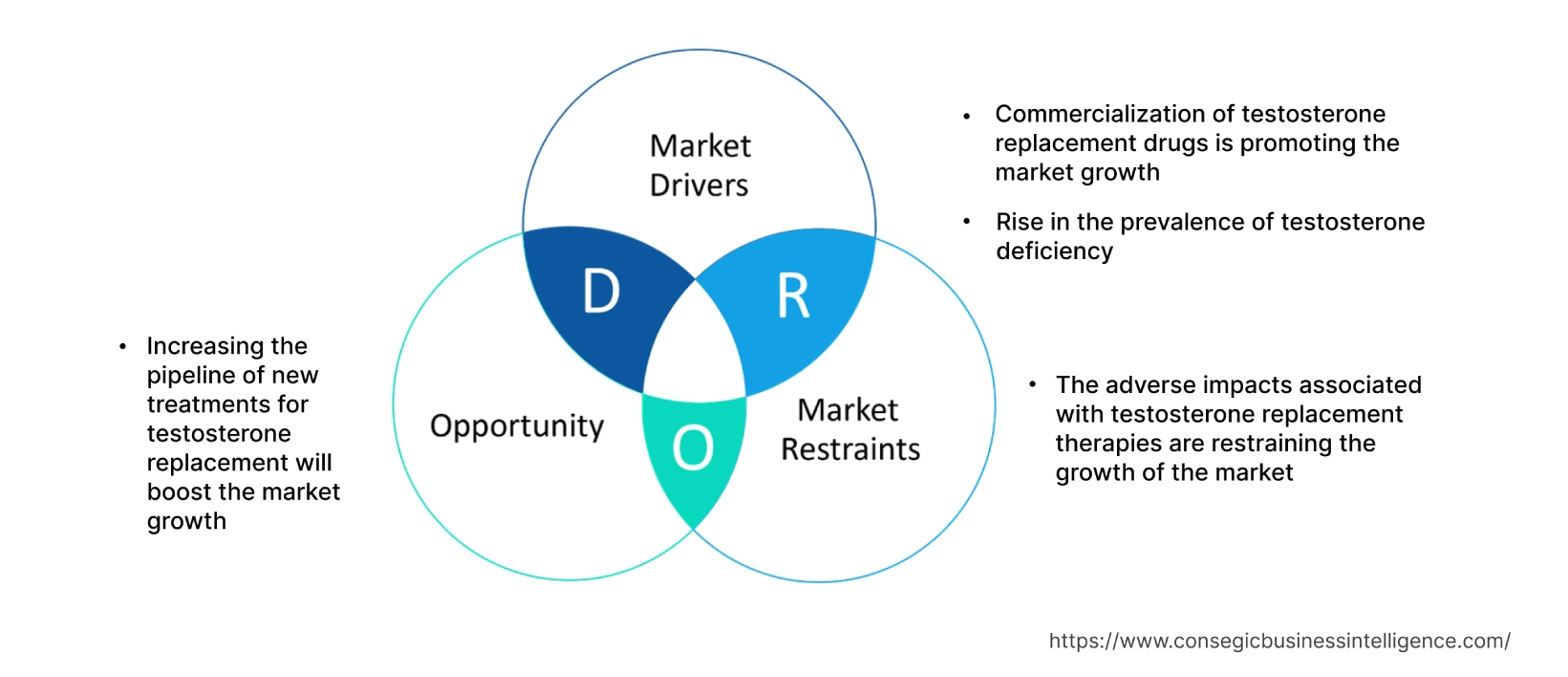- Summary
- Table Of Content
- Methodology
Testosterone Replacement Therapy Market Size :
Consegic Business Intelligence analyzes that the testosterone replacement therapy market size is growing with a healthy CAGR of 4.3% during the forecast period (2023-2030), and the market is projected to be valued at USD 2,556.13 Million by 2030 from USD 1,836.00 Million in 2022.
Testosterone Replacement Therapy Market Scope & Overview:
Testosterone replacement therapy is a category of hormone therapy in which androgens, are boosted or replaced. The prominent types of testosterone replacement therapies include gel, injection, patch, implantable pellets, drugs, and others. These therapies improve the symptoms and signs of low testosterone in men. Furthermore, the above treatment therapies counter the signs and symptoms of male hypogonadism, including decreased energy, reduction in sexual desire, loss of muscle mass & bone density, and decreased facial & body hair. As a result of the above-mentioned benefits, the adoption of this therapy is increasing in hospitals, homecare settings, specialty clinics, and others.
Testosterone Replacement Therapy Market Insights :
Key Drivers :
Commercialization of testosterone replacement drugs is promoting the market growth
The prominent manufacturers in the testosterone replacement therapy industry are leveraging their potential for the commercialization of testosterone replacement drugs. As a result of this, the availability of testosterone replacement drugs in the global market is increasing. For instance, in August 2022, the United States Food and Drug Administration (FDA) approved Kyzatrex (testosterone undecanoate). Kyzatrex is utilized as a therapy in adult males. The product is ideal for the treatment of primary hypogonadism and hypogonadotropic hypogonadism. Based on the analysis, these conditions pose a deficiency or absence of endogenous testosterone. Therefore, the increasing commercialization of testosterone replacement drugs is boosting the testosterone replacement therapy market trends.
Rise in the prevalence of testosterone deficiency
Testosterone replacement therapy is critical for use in the treatment of testosterone deficiency because the therapy enhances bone density, insulin sensitivity, and muscle mass. For instance, according to a recent article published by the Indian Journal of Endocrinology and Metabolism, in 2022, the prevalence of testosterone deficiency among Indian men in the age group of 60-88 years was 21.67%. Hence, as per the analysis, the increase in the prevalence of testosterone deficiency at the global level is boosting testosterone replacement therapy market demand to ensure improvement in mood from testosterone replacement. This, in turn, is favoring the testosterone replacement therapy market growth.
Key Restraints :
The adverse impacts associated with testosterone replacement therapies are restraining the growth of the market
Testosterone replacement therapy has several side effects and risks associated with the health of the patients. This prominent factor is restraining the trends of the market. For instance, according to the Mayo Foundation for Medical Education and Research (MFMER), the therapy can pose risks related to acne, sleep disturbances, limited sperm production, increased production of red blood cells, and others. Based on the analysis, these conditions can have serious health implications. Thus, the various health impacts associated with these therapy are posing a bottleneck for the trends and demand of the market during the projected forecast period.
Future Opportunities :
Increasing the pipeline of new treatments for testosterone replacement will boost the market expansion
The key trends such as the increasing prevalence of testosterone deficiency, partnerships between leading players dealing in these therapies, investment in research & development activities, and others are prompting new initiatives for the studies related to these therapy. As per the analysis, this factor is leading to the increasing pipeline for the treatment of this therapy. For instance, in June 2023, Cleveland Clinic-led clinical trial for this therapy showcased the results that the use of the therapy is incapable of inducing adverse cardiac concerns for men with low testosterone. Thus, the increasing pipeline for the treatment of this therapy will create lucrative testosterone replacement therapy market opportunities and trends in the coming years.
Testosterone Replacement Therapy Market Report Insights :
| Report Attributes | Report Details |
| Study Timeline | 2017-2030 |
| Market Size in 2030 | USD 2,556.13 Million |
| CAGR (2023-2030) | 4.3% |
| By Product Type | Gel, Injection, Patch, Implantable Pellets, Drugs, and Others |
| By End User | Hospitals, Homecare, Specialty Clinics, and Others |
| By Region | North America, Europe, Asia-Pacific, Latin America, and Middle East & Africa |
| Key Players | Endo Pharmaceuticals Inc, Pfizer, Inc, Eli Lilly and Company, Bayer AG, Teva Pharmaceutical Industries Ltd, Ferring Pharmaceuticals, Acerus Pharmaceuticals Corporation, Mylan N.V., Upsher-Smith Laboratories, and Biote |
| Geographies Covered | |
| North America | U.S. Canada Mexico |
| Europe | U.K. Germany France Spain Italy Russia Benelux Rest of Europe |
| APAC | China South Korea Japan India Australia ASEAN Rest of Asia-Pacific |
| Middle East and Africa | GCC Turkey South Africa Rest of MEA |
| LATAM | Brazil Argentina Chile Rest of LATAM |
| Report Coverage | Revenue Forecast, Competitive Landscape, Growth Factors, Restraint or Challenges, Opportunities, Environment & Regulatory Landscape, PESTLE Analysis, PORTER Analysis, Key Technology Landscape, Value Chain Analysis, Cost Analysis, and Regional Trends & Forecast |
Testosterone Replacement Therapy Market Segmental Analysis :
By Product Type :
The product type segment is categorized into gel, injection, patch, implantable pellets, and others. In 2022, the injection segment accounted for the highest market testosterone replacement therapy market share of 31.01% in the overall testosterone replacement therapy market. Based on the analysis, testosterone replacement injections such as testosterone enanthate, testosterone cypionate (Depo-Testosterone), and others are widely employed for the treatment of testosterone deficiency. These products help in maintaining the male hormone levels to address concerns related to low testosterone. Moreover, the prominent benefits associated with testosterone replacement injections include increased sex drive, improved symptoms of erectile dysfunction (ED), and an increased sperm count, among others. As a result of the above-mentioned benefits, various leading players in testosterone replacement injection manufacturers are developing a new range of products. For instance, in April 2023, Xiromed LLC, a leading biotechnology company in the United States launched Testosterone Cypionate Injection named Depo-Testosterone. Henceforth, the introduction of a new range of testosterone replacement injections to ensure cost-effectiveness in the treatment of testosterone deficiency is benefiting the market demand and trends at the global level.
However, the gel segment is expected to be the fastest-growing segment during the forecast period. This is due to the increasing adoption of gels for the treatment of testosterone deficiency in homecare settings, which is fostering segmental trends and demand in the coming years.
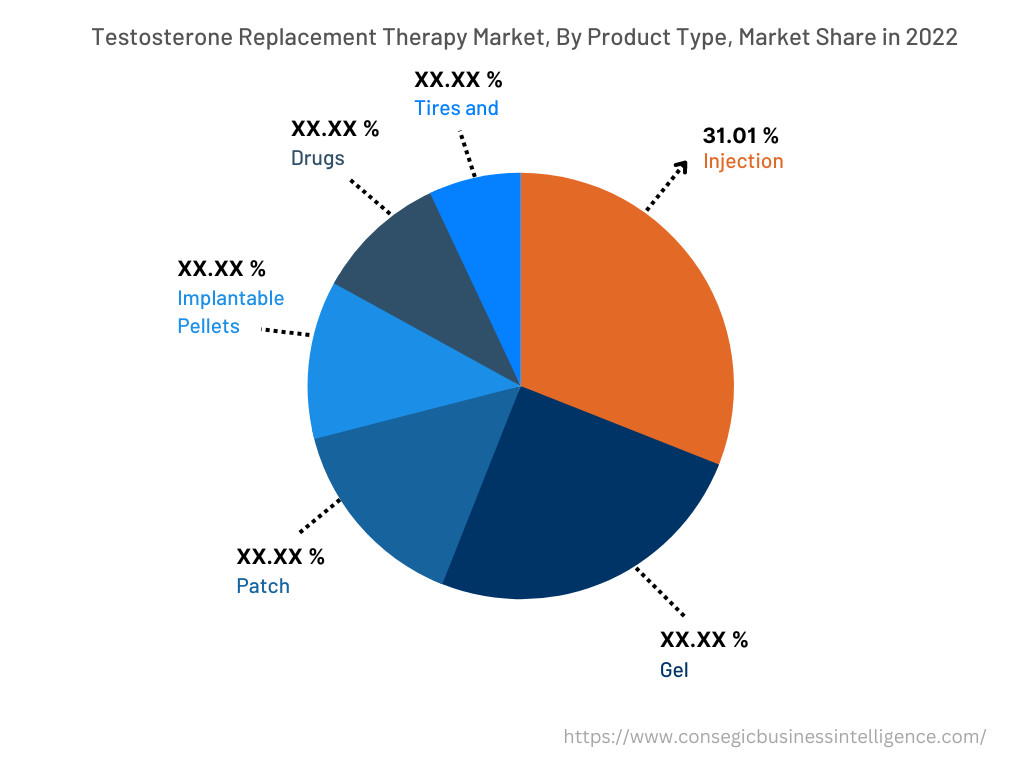
By End User :
The end user segment is categorized into hospitals, homecare, specialty clinics, drugs, and others. In 2022, the specialty clinics segment accounted for the highest market share in the testosterone replacement therapy market. The prime benefits of this therapy include beneficial effects on mood & energy levels, efficient fat distribution, the appropriate level of production of red blood cells & sperm, and others. As a result, based on the analysis, the therapy is utilized in specialty clinics. For instance, various specialty clinics are providing treatment for testosterone deficiency, including Men's T Clinic (United States), Harpal Clinic (United Kingdom), Men's Clinic at UCLA (United States), and others. These clinics utilize this therapy for the treatment of testosterone deficiency. Hence, the increasing adoption of this therapy in specialty clinics to enhance the testosterone level is bolstering market demand.
However, the hospitals segment is expected to be the fastest-growing segment during the forecast period. This trends is attributed to factors such as increasing investment in new hospitals, government initiatives for healthcare infrastructure, and others.
By Region :
The regional segment includes North America, Europe, Asia Pacific, the Middle East and Africa, and Latin America.
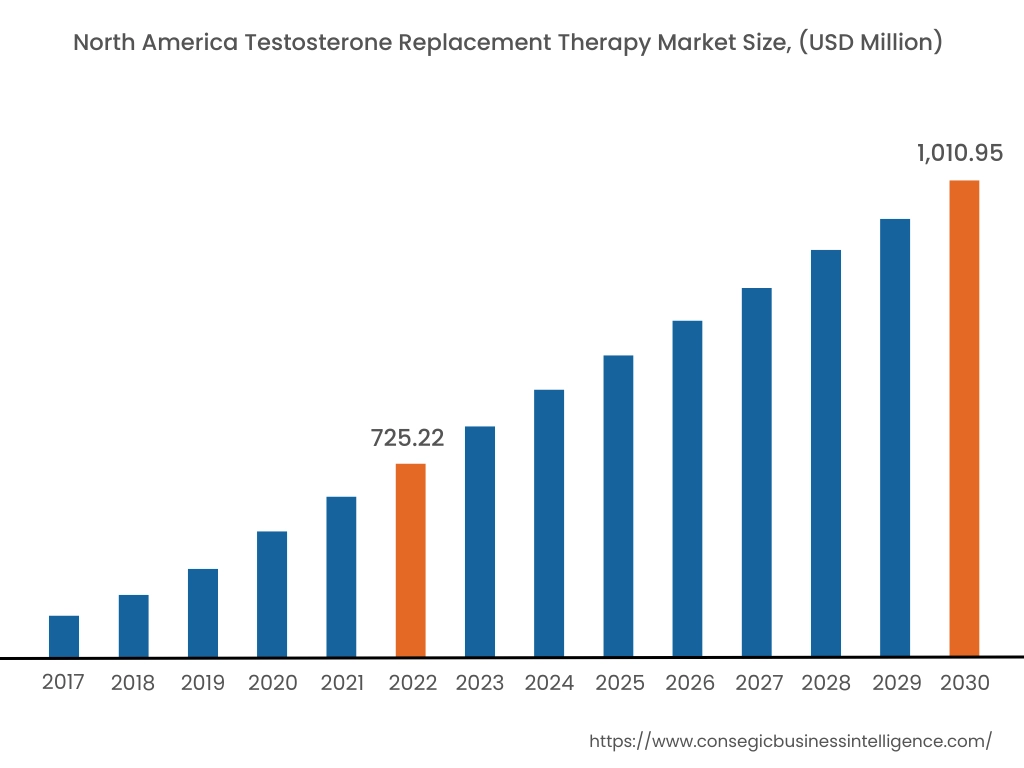
In 2022, North America accounted for the highest market share at 39.50% and was valued at USD 725.22 million, and is expected to reach USD 1,010.95 million in 2030. In North America, the U.S. accounted for the highest market share of 69.77% during the base year of 2022. Based on the testosterone replacement therapy market analysis, the expansion of product offerings for this therapy is attributed to the market growth in the North American region. For instance, in March 2022, Antares Pharma, Inc., a specialized pharmaceutical company based in the United States and Lipocine, a pharmaceutical manufacturer in the United States expanded the product offering for this therapy, named Xyosted. Xyosted is an oral treatment solution for testosterone deficiency. Hence, the expansion of product offerings in the North American region is supplementing the market growth.
Furthermore, Asia Pacific is expected to witness significant growth over the forecast period, growing at a CAGR of 5.1% during 2023-20230. This is due to the exponential growth in the adoption of this therapy by end users such as hospitals, specialty clinics, and others.
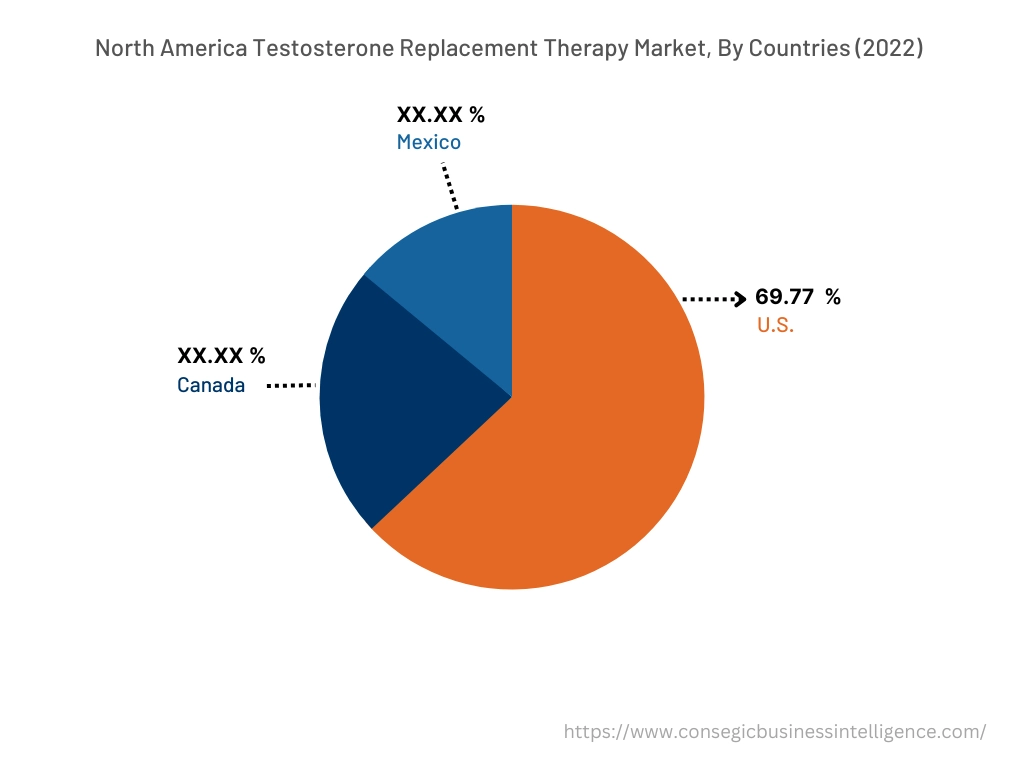
Top Key Players & Market Share Insights :
The global testosterone replacement therapy market is highly competitive, with several large players and numerous small and medium-sized enterprises. These companies have strong research and development capabilities and a strong presence in the market through their extensive product portfolios and distribution networks. The market is characterized by intense competition, with companies focusing on expanding their product offerings and increasing their market share through mergers, acquisitions, and partnerships. The key players in the testosterone replacement therapy industry include-
- Endo Pharmaceuticals Inc
- Pfizer, Inc
- Mylan N.V.
- Upsher-Smith Laboratories
- Biote
- Eli Lilly and Company
- Bayer AG
- Teva Pharmaceutical Industries Ltd
- Ferring Pharmaceuticals
- Acerus Pharmaceuticals Corporation
Recent Industry Developments :
- In March 2022, Halozyme Therapeutics, Inc., a United States-based manufacturer of testosterone replacement therapy launched TLANDO (testosterone undecanoate), an oral testosterone replacement therapy. Thus, the development of a new range of testosterone replacement therapy is benefiting the market growth.
Key Questions Answered in the Report
What was the market size of the testosterone replacement therapy industry in 2022? +
In 2022, the market size of testosterone replacement therapy was USD 1,836.00 million
What will be the potential market valuation for the testosterone replacement therapy industry by 2030? +
In 2030, the market size of testosterone replacement therapy will be expected to reach USD 2,556.13 million.
What are the key factors driving the growth of the testosterone replacement therapy market? +
Commercialization of testosterone replacement drugs is promoting market growth.
What is the dominating segment in the testosterone replacement therapy market by product type? +
In 2022, the injections segment accounted for the highest market share of 31.01% in the overall testosterone replacement therapy market.
Based on current market trends and future predictions, which geographical region is the dominating region in the testosterone replacement therapy market? +
North America accounted for the highest market share in the overall testosterone replacement therapy market.
